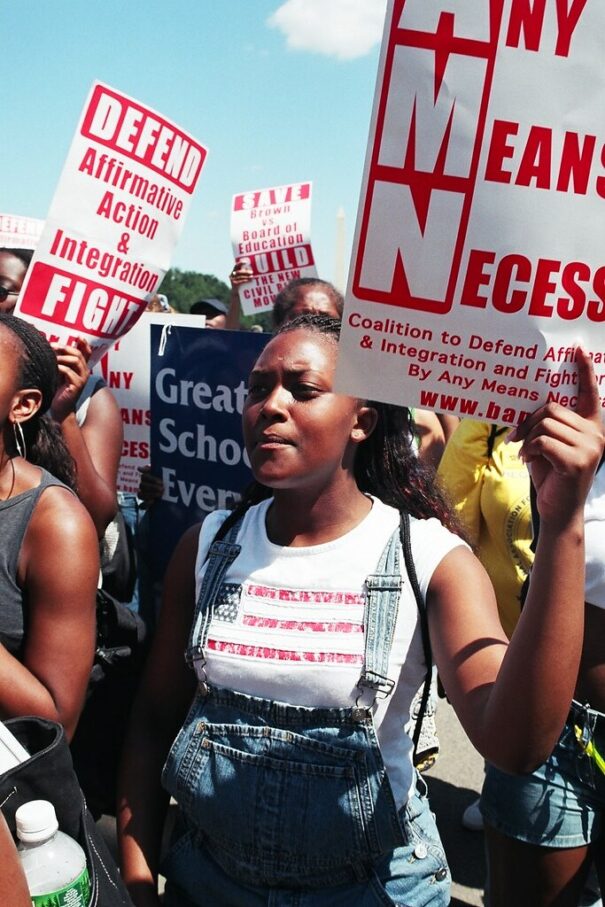
Photo by Elvert Barnes
In a devastating blow to progress, the Supreme Court’s 2023 decision to overturn affirmative action in college admissions has begun to unravel decades of hard-won gains for women and students of color in higher education and beyond. Recent statistics from Brown University reported a 40% drop in Black student enrollment in their 2024 freshman class, a disappointing yet predictable outcome. Affirmative action has long been a cornerstone of feminist advocacy, serving as a vital tool to dismantle systemic barriers that have historically excluded marginalized groups from white male-dominated fields. By promoting diversity in higher education, these policies have opened doors for countless women, particularly in STEM fields, where gender disparities remain stark.
The gains made through affirmative action are undeniable. Since its implementation, we’ve seen a significant increase in women’s enrollment in universities and their representation in professional schools. This progress has translated into greater economic opportunities and representation in leadership positions across various sectors. Opponents of affirmative action often tout the idea of a “merit-based” system as a fair alternative. However, this argument fundamentally misunderstands the deep-seated inequalities that persist in our education system and society at large. Standardized tests and traditional metrics of academic achievement often reflect privilege more than true potential or merit.
For women, especially those from marginalized communities, these “merit-based” systems can be particularly punitive. They fail to account for the additional hurdles women face, such as gender bias in STEM education, the disproportionate burden of family care responsibilities, and the subtle yet pervasive discouragement of girls from pursuing certain career paths. Affirmative action, flawed as it might have been, was one of the few tools we had to address these compounded disadvantages. It recognized that equality sometimes requires equity – a level playing field isn’t truly level if some players start miles behind the line.
As a Black woman in the feminist movement, I’ve always known that my experience of gender discrimination is inextricably linked with my knowledge of racial bias. This understanding – intersectionality – isn’t just academic jargon; it’s the lived reality for millions of women across America. Kimberlé Crenshaw’s groundbreaking work on intersectionality in the late 1980s gave us the language to articulate what many of us had long known: oppression doesn’t exist in a vacuum. The challenges faced by a working-class Latina mother in the Bronx fundamentally differ from those encountered by a middle-class white woman in suburbia. Both experience sexism, yes, but the former also grapples with racism, classism, and, often, linguistic discrimination.
I remember my college application process three years ago. Affirmative action policies allowed me to show who I indeed was – not just a set of numbers, but a determined young woman with dreams of making a difference. That opportunity changed the trajectory of my life. But it wasn’t just about me. I saw firsthand how different perspectives enriched our learning in that diverse college environment. My best friend, a white girl from Wisconsin, challenged my urban-centric views. My study group, a mix of races, genders, and socioeconomic backgrounds, taught me more about problem-solving than any textbook ever could.
The Supreme Court’s decision threatens to unravel this tapestry we’ve so carefully woven. It’s not just about college admissions – it’s about who gets to be in the rooms where decisions are made, whose voices are heard in policy discussions, who gets to shape the future of our nation. By limiting diversity in higher education, we risk perpetuating gender imbalances in high-paying professions, leadership positions, and policy-making roles. This, in turn, hampers our ability to address gender-based issues effectively and comprehensively in all spheres of society.
Moreover, diverse educational environments have been shown to benefit all students, fostering creativity, critical thinking, and a more nuanced understanding of complex social issues. By dismantling affirmative action, we’re not just holding back women and minorities; we’re diminishing the quality of education for everyone. I think of the young girls in the younger generations – Black, Latina, Asian, Indigenous – all bright-eyed and full of potential. How do we tell them that the doors cracked open for my generation might be slamming shut for theirs?